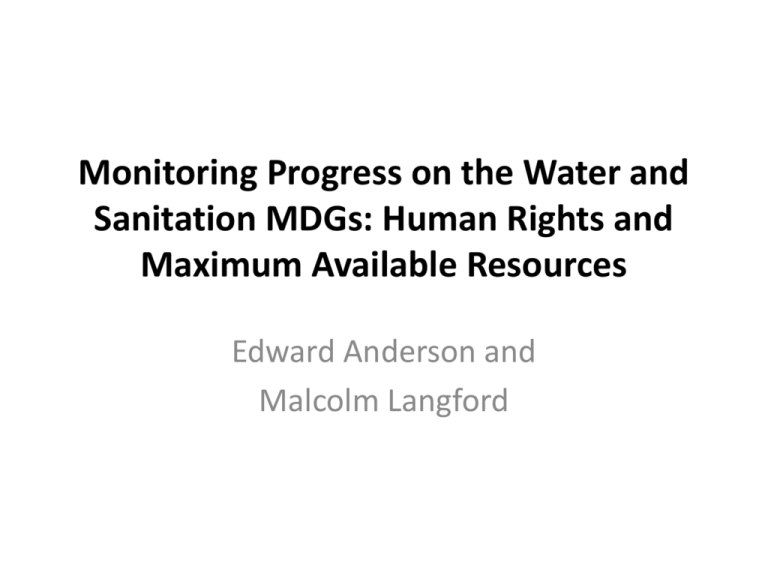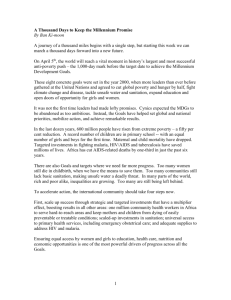Monitoring Progress on the Water and Sanitation MDGs: Human
advertisement

Monitoring Progress on the Water and Sanitation MDGs: Human Rights and Maximum Available Resources Edward Anderson and Malcolm Langford The Rights and Resources Critique of the MDGs • The Millennium Development Goals have been commonly interpreted and used as national targets. • But criticism: from a human rights perspective, the MDGs fail to take into account the more nuanced obligations of State’s under international law. • This includes the duty to use the maximum available resources to realise social rights. • The result is that the MDGs framework may wrongly reward countries for performance on social rights; favouring middleincome countries and discriminating against poorer countries Even more concerning since Majority of Poverty now in Middle-Income Countries Standard Measurements on MDGs Numbers of States ”On Track” Alternative 1: Have countries accelerated post2000? (‘progressively realised’) Fukuda-Parr and Greenstein (2010; 2012) Alternative 2: Have countries used their maximum available resources? • We test performance on two MDG targets and UN-recognised rights, water and sanitation, from the perspective of a country’s maximum available resources. • A number of proxy indicators are used to measure resources, including: GDP, dependency ratio, population shares, aid, educational levels and water resources. • The relationship between resources and progress on access to water and sanitation is measured for resources at both points in time and for changes over time. Access to improved water source (%) 1990 1995 2000 2005 2010 Mean 80 81 83 85 87 Mean, pop weighted 76 79 83 86 88 Minimum 14 2 22 26 29 Maximum 100 100 100 100 100 No. of countries 164 189 191 187 174 Access to improved sanitation (%) 1990 1995 2000 2005 2010 Mean 66 66 69 71 72 Mean, pop weighted 48 52 56 60 63 Minimum 3 4 7 9 9 Maximum 100 100 100 100 100 No. of countries 149 181 189 187 171 Levels: water 1 2 GDP per capita (US$ PPP) 4.1*** 4.4*** Population 1.5*** 1.7*** Land area -2.3*** -2.1*** Urban population (%) 0.2*** 0.1*** Dependency ratio -37.0*** -24.3*** Water resources -0.1 0.3 - 1.2*** No. of observations 720 533 R2 0.72 0.75 Average years of schooling (ages 15+) Levels: sanitation 1 2 11.9*** 10.7*** Population 1.3** 1.9*** Land area -1.9*** -3.0*** Urban population (%) 0.1*** 0.1 Dependency ratio -53.9*** -24.1*** Water resources -0.9** -0.3 - 3.1*** No. of observations 705 533 R2 0.74 0.75 GDP per capita (US$ PPP) Average years of schooling (ages 15+) Changes: water 1 2 0.7 0.7 Population 9.9*** 11.5*** Land area - - Urban population (%) 0.2*** 0.2*** Dependency ratio -5.6** -4.4 Water resources - Average years of schooling (ages 15+) - -0.1 No. of observations 604 430 R2 0.10 0.14 GDP per capita (US$ PPP) Changes: sanitation 1 2 GDP per capita (US$ PPP) 1.5*** 1.9** Population 4.0** 2.5 Land area - - 0.4*** 0.4*** Dependency ratio -18.3*** -12.2*** Water resources - Average years of schooling (ages 15+) - 0.2 No. of observations 591 417 R2 0.22 0.22 Urban population (%) Outliers: water (levels) Country Year Actual access (%) Predicted access (%) Difference Libya 2000 54 89 -35 Equatorial Guinea 2005 51 83 -32 Mauritania 1990 30 60 -30 Madagascar 1990 29 58 -29 Guinea-Bissau 1990 36 65 -29 Papua New Guinea 2010 40 68 -28 Sierra Leone 1990 38 66 -28 Madagascar 1995 33 60 -27 Papua New Guinea 2000 39 66 -27 Papua New Guinea 1995 40 66 -26 Outliers: sanitation (levels) Country Year Actual access (%) Predicted access (%) Difference Gabon 2010 33 78 -45 Gabon 2005 33 73 -40 Gabon 1995 36 70 -34 Congo, Rep. 2010 18 52 -34 Gabon 2000 36 70 -34 Ghana 2010 14 48 -34 Ghana 2000 10 43 -33 Haiti 2010 17 50 -33 Bolivia 1990 18 50 -32 Bolivia 1995 21 53 -32 Outliers: water (changes) Country End year Actual change (%) Predicted change (%) Difference West Bank and Gaza 2000 -5 3 -8 Yemen, Rep. 1995 -4 4 -8 Algeria 2000 -4 3 -7 Jordan 1995 -1 6 -7 Algeria 2005 -4 3 -7 West Bank and Gaza 2005 -4 3 -7 Yemen, Rep. 2000 -3 4 -7 Yemen, Rep. 2005 -3 4 -7 Rwanda 2000 0 6 -6 Sudan 1995 -2 3 -5 Outliers: sanitation (changes) Country End year Actual change (%) Predicted change (%) Difference Djibouti 2005 -6 3 -9 Jordan 1995 0 8 -8 Djibouti 2000 -5 3 -8 Haiti 2005 -3 4 -7 Gabon 2005 -3 4 -7 Haiti 2000 -3 3 -6 Haiti 2010 -2 4 -6 Nigeria 2000 -2 3 -5 Liberia 2000 1 6 -5 Bhutan 2005 2 7 -5 Interpretation • Government capacity to improve access to water and sanitation depends various factors, including but not limited to GDP per capita • By controlling for these indicators using regression analysis we can obtain a better indication of government ‘effort’ or priority attached to water and sanitation • Key challenges remain in the choice of capacity indicators • The method can however be used to guide more detailed, countrylevel analysis on progress and government efforts








